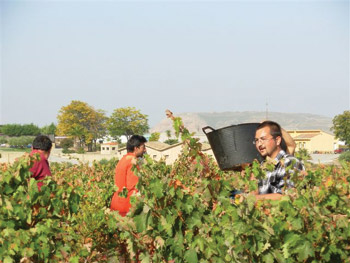Classic accident: Spanish Rioja

Helen Coburn visits the picturesque home of Rioja and learns the magic of tempranillo
11 November 2008
The great classic wine styles often happen by accident rather than design and Spain’s Rioja is no exception. Rioja is one of the world’s great oak aged wines and its time in barrel has historically only been matched by Italy’s Barolo. It rose to fame during the 18th century when producers began to age it in French oak casks of at least 1500 litres. Financial necessity drove 19th century producers toward American oak (even today, American barrels are about half the price of French) but it turned out to be a happy accident.
The flavours of the two principal Rioja grapes, tempranillo and garnacha, are gently enriched by the vanilla and creamy spices imparted by American oak and aged wines tend to have slightly squashy summer fruit and leather aromas, with flavours of dried orange, strawberry, leather and subtle spices.
Tempranillo posseses an enzyme which enables it to age well even when acidity is low but the naturally acidic graciano is often added to the Rioja blend to supply extra insurance, especially as garnacha, too, runs to lowish acidity. Graciano is also a deeply coloured variety so it helps intensify the hue of the two main grapes. Small proportions of mazuelo are also traditionally used, but modern makers have tended to dismiss it on quality grounds. This is a little unfair, for manzuelo is the carignan of France and, well handled, it supplies good tannins and also tends to preserve fruit flavours during ageing.
I was lucky enough to visit Rioja during this year’s harvest. It hadn’t been planned that way but, as it happened, harvest in Rioja was about a fortnight later than usual and, at Marques de Murrieta, I got the chance to get right in there among the pickers. Picking is hot work, even when it’s well into October; in fact, I reckon it’s the hardest job of all in wine production.
Murrieta is a traditional house, which means it still uses a lot of American oak, unlike some of the modernisers who have gone entirely over to French. Personally, I think the modernisers have embraced French oak too eagerly, as I feel that it tends to dry out Tempranillo and to muffle its aromas as the wine ages. When it comes to the Rioja blend, I think American oak or a mix of French and American, gives a more classic expression of the grapes. But this is a personal view, I hasten to say, and, yes, it is all too easy to turn into a wine Luddite especially in these grand old regions of Europe.
However, the Luddite can be happy at Marques de Murrieta, for here they make a fine distinction between their modern expression, in the shape of Dalmau (all French oak and a bit of Cabernet), and the traditional bottlings, Murrieta Reserva and Castillo Ygay. There is also a fine white, made, as is traditional, from the Viura grape, and aged for 2 years in American barrels. We were offered a sampling of the Ygay 1978 which was only bottled in 1998 after 221 months of oak ageing; it’s beginning to dry a little but has lovely smooth leathery flavours, and earth, orange laced, stewed plum fruits. Not that 221 month ageing is anything to Murrieta; they bottled their 1942 in 1983, but this I have never managed to taste.If you want to get hold of more available vintages, Gilbey’s are the importers, and the Ygay 2000 and Reserva 2000 are drinking well.
Marques de Caceres (FindlaterGrant) is in much more modern style and all oak is French. As it happens, the founder of the estate spent many years in Bordeaux, and it’s clear that French classics are the role model here. To my mind, the Red Reserva is consistently both the best wine and best value wine of the range, with the French oak skilfully used so as not to lose the character of the tempranillo. The current vintage is 2002 and it’s up to standard, with a tiny trace of coconut beneath plum, berry and truffle flavours- perfect for a turkey dinner.
Domeq are a famed house also producing a fairly modern style of small production Rioja under the Ysios label, but oddly enough the more familiar Campo Viejo (Irish Distillers) range seemed to show a little better, with the Gran Reserva 2001, in particular, being very tasty, with soft strawberry and orange flavours, nicely laced with soft leathery notes. The Reserva 2004 is sound too, and as generally with this label, good value for what you get.
Of course, it’s not all just wine in Rioja; this is a scenic region with plenty of good hotels and restaurants. For Irish drivers it makes a dream tour, with its fine, open roads and little traffic congestion. For most of the year, Aer Lingus flies into Bilbao which is very close to the vineyard region and is a good base, or, even better, you can stay in the town of Haro, where many of the venerable Rioja names keep cellars. Many historic buildings in the region have been sympathetically converted to hotels and they tend to be better value than those in the top wine areas of Italy.



 Print
Print






Fans 0
Followers